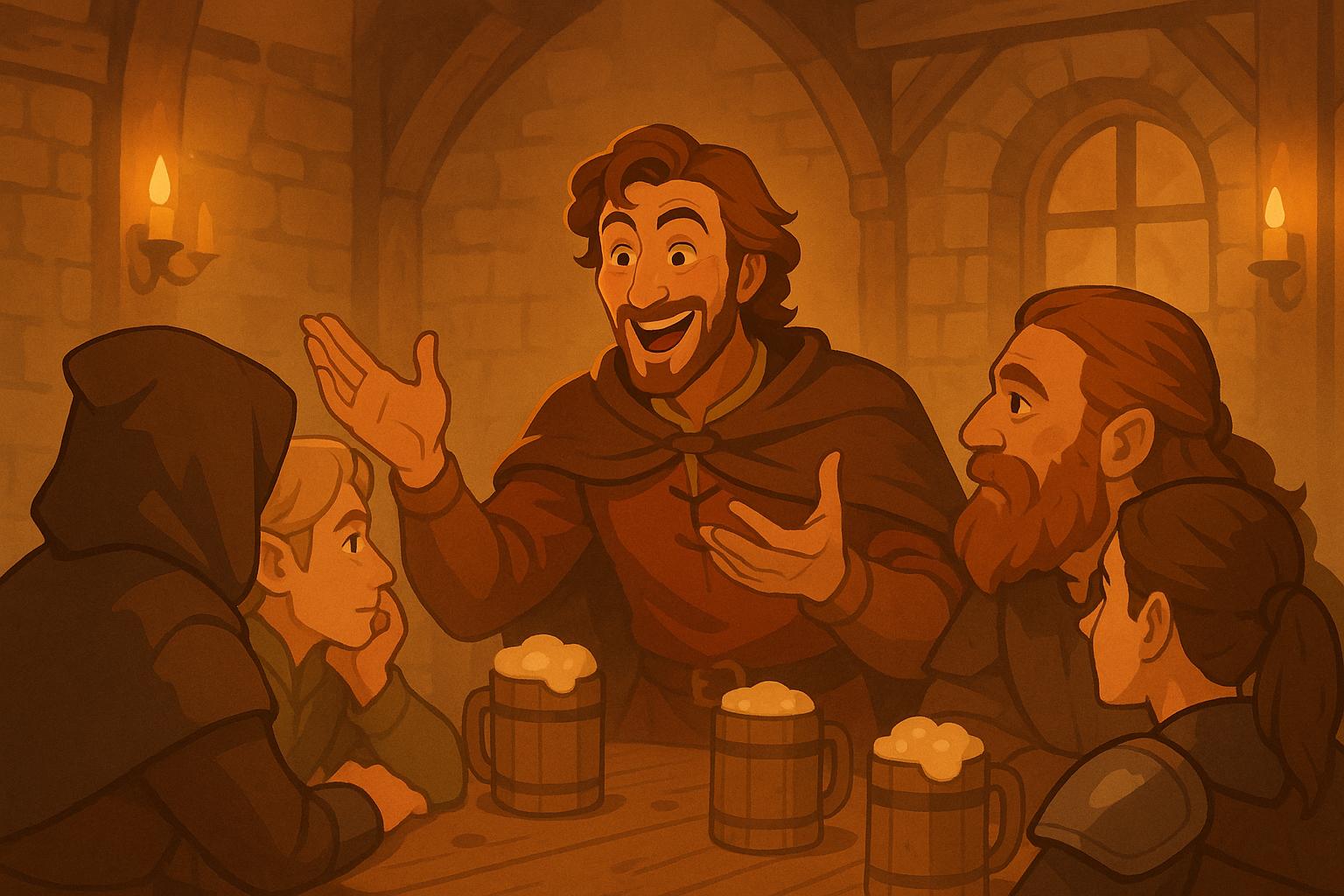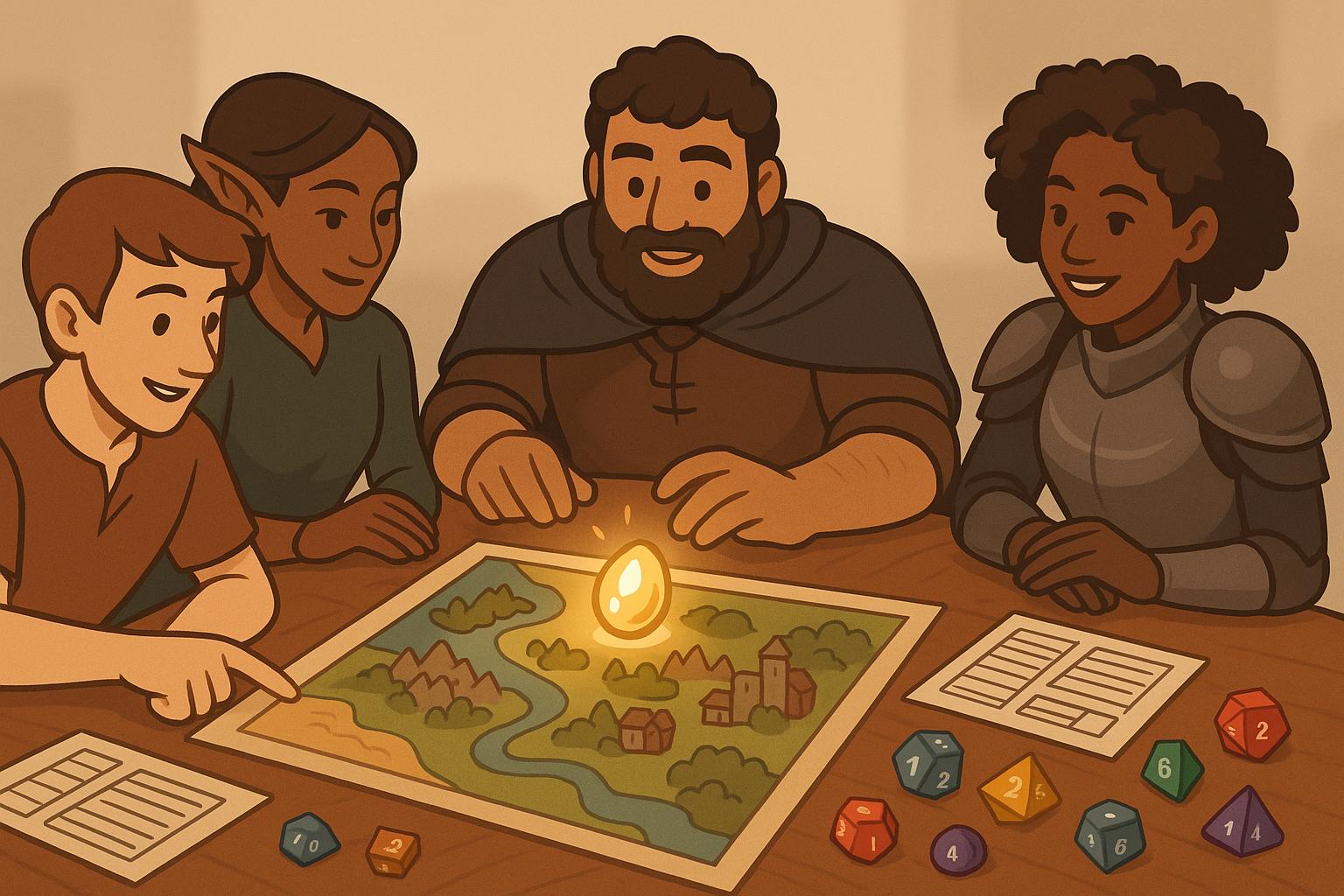Indie tabletop role-playing games (TTRPGs) are transforming the gaming scene by offering bold, experimental systems that emphasize storytelling and creativity. From fast-paced heists to dungeon crawls with modern twists, these games provide fresh experiences for players and Game Masters alike. Here’s a quick overview of the standout indie TTRPGs you should explore:
- Blades in the Dark: A game of crime, heists, and supernatural intrigue with dynamic mechanics like flashbacks and faction systems.
- Shadowdark: A modern take on old-school dungeon crawling with real-time torch mechanics and streamlined rules.
- Dreams and Machines: A post-apocalyptic sci-fi world focused on rebuilding society using a 2d20 system.
- Pirate Borg: A pirate-themed RPG blending naval combat with supernatural horror.
- Dragonbane: A revival of a classic fantasy RPG with roll-under mechanics and flexible character creation.
- Legend in the Mist: A narrative-driven game where character backstories replace traditional stats.
- :Otherscape: A cyberpunk RPG mixing ancient mythology with futuristic tech, built on a tag-based system.
- Esoteric Ebb: A post-arcanepunk world with tactical dialogue and a branching storytelling system.
- Aether & Iron: A 1930s-inspired sky city RPG featuring vehicular combat and cosmic horror elements.
- Tsukuyumi: The Divine Hunter: A roguelike deckbuilder set in a mythological, post-apocalyptic Tokyo.
These games are perfect for groups seeking unique mechanics, immersive worlds, and a break from conventional systems. PDFs generally cost $15–40, with physical editions ranging from $30–80. Many also offer free starter sets to help you get started.
Sleeper Hits of the Indie TTRPG Scene | Independent July
Quick Comparison
| Game | Core Mechanics | Theme & Setting | Cost |
|---|---|---|---|
| Blades in the Dark | Flashbacks, faction systems | Crime and supernatural intrigue | $20–40 |
| Shadowdark | Simplified d20, real-time torches | Modern dungeon crawling | $25–50 |
| Dreams and Machines | 2d20 system | Post-apocalyptic sci-fi | TBD |
| Pirate Borg | Rules-light, naval combat | Supernatural pirate adventures | ~$20–40 |
| Dragonbane | Roll-under, skill-based | Classic fantasy | $30–60 |
| Legend in the Mist | Narrative-driven, no stats | Mythology and everyday life | $29–50 |
| :Otherscape | Tag-based system | Cyberpunk meets mythology | $29.95–49.95 |
| Esoteric Ebb | Tactical dialogue, branching story | Post-arcanepunk intrigue | TBD |
| Aether & Iron | Vehicular combat, noir elements | 1930s sky city with cosmic horror | TBD |
| Tsukuyumi: Divine Hunter | Roguelike deckbuilder | Mythological post-apocalyptic Tokyo | Free-to-play |
These indie TTRPGs offer something for every type of player, whether you’re into fast-paced action, deep narratives, or experimental mechanics. Dive in and discover a game that could redefine your tabletop experience.
1. Blades in the Dark
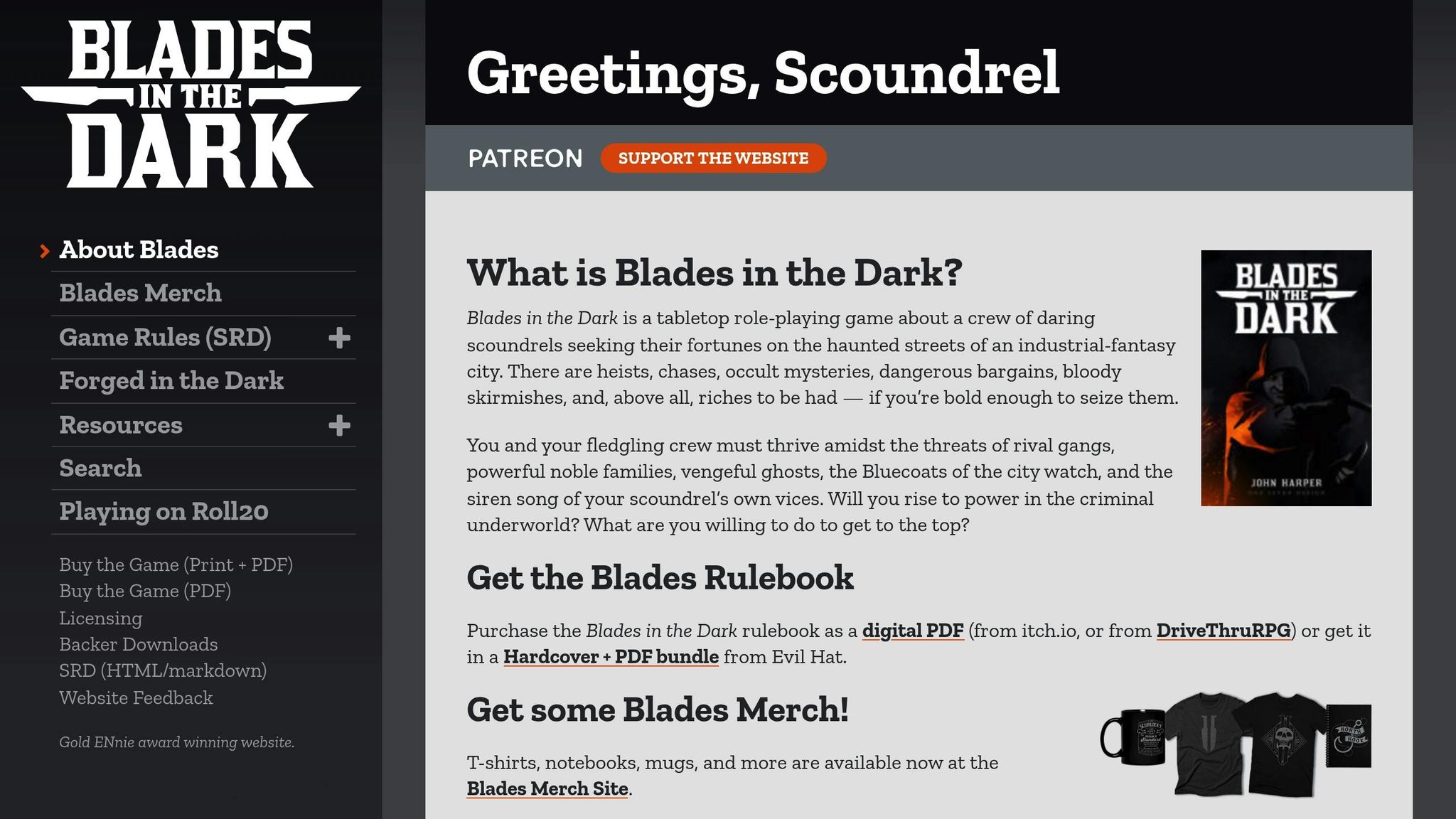
Set in the steampunk-inspired industrial city of Duskvol, Blades in the Dark plunges players into a gritty world where crime syndicates rule the streets, and supernatural forces lurk in the shadows. This isn't just a game about pulling off heists - it's about weaving intricate stories of ambition, danger, and consequence.
What sets Blades in the Dark apart is its fresh take on the classic heist formula. Instead of spending hours meticulously planning every detail before the action starts, the game dives straight into the action. The flashback mechanic is a game-changer, allowing players to retroactively set up clever plans - like revealing a hidden escape route or orchestrating a perfectly timed distraction. This keeps the pace fast and the tension high.
"Blades in the Dark is one of the greatest RPGs of the last decade, full stop. It's not a game: it's a thesis on how RPGs can be different, how they can allow players and construct stories out of momentum, consequences, and cool cinematic action." - Serban Ionita, The RPG Gazette
The game’s Clock system and dynamic faction mechanics add layers of depth. Clocks track progress and consequences, while the faction network ensures that every decision - whether forming alliances or sparking rivalries - has lasting effects on the city of Duskvol.
Mechanically, the game uses a modified version of the Apocalypse World system, relying on six-sided dice. Players take the highest roll to determine success, creating a seamless transition between action-packed heists, high-stakes moments, and the quieter downtime that follows. This cyclical gameplay mirrors the rise and fall of a criminal empire, balancing chaos with moments of reflection.
Since its debut in 2015 and a record-breaking Kickstarter campaign in 2016, Blades in the Dark has earned widespread acclaim and multiple awards. Published by Evil Hat Productions, it’s perfect for groups who love collaborative storytelling and enjoy a bit of improvisation. The game also adapts well to larger groups, giving the GM the tools to keep the narrative flowing without getting bogged down in endless dice rolls.
At its core, Blades in the Dark is about player-driven storytelling. Every decision shapes a world brimming with crime, politics, and the supernatural, ensuring that your crew’s legacy grows with each daring score.
2. Shadowdark

Shadowdark reimagines classic dungeon crawling by combining the nostalgic essence of old-school role-playing games with modern design sensibilities. It’s not just another retro-inspired game - it’s a fresh take that bridges decades of evolution in tabletop gaming.
One of the standout features of Shadowdark is its real-time torch mechanic. When your character lights a torch, a one-hour tabletop timer starts ticking, creating a palpable sense of urgency as the encroaching darkness becomes a constant threat to your party.
The game simplifies gameplay without compromising its depth, thanks to its streamlined math system. Combat remains familiar, using d20 mechanics with ability modifiers, but it also incorporates a gritty, old-school flavor. The always-on initiative system keeps players actively engaged, while the game’s design encourages creative problem-solving rather than relying solely on character sheet abilities.
The numbers reflect Shadowdark’s success. Its Kickstarter campaign raised over $1.3 million, and it dominated the 2024 awards season, earning four gold ENNIEs: Product of the Year, Best Game, Best Rules, and Best Layout & Design. With an impressive 4.94 out of 5.0 rating from 364 reviews, it’s clear the game has struck a chord with players.
Shadowdark also adds strategic depth with its gear slot system. Characters can carry a limited number of items based on their Strength score or 10, whichever is higher. This forces players to make meaningful choices about what to bring on their adventures, adding another layer of tension and strategy.
For groups looking for low-prep gaming, Shadowdark is a perfect fit. Its design allows Game Masters to run exciting sessions with minimal preparation, keeping the focus on storytelling and improvisation. The core rulebook is priced at $60, while a physical starter set is available for $20. For those curious to try it out, the PDF starter set can be downloaded for free, making it easy to test the waters with your group.
With its clever mechanics and engaging design, Shadowdark has set a new standard for modern dungeon crawlers, paving the way for even more inventive games to come.
3. Dreams and Machines
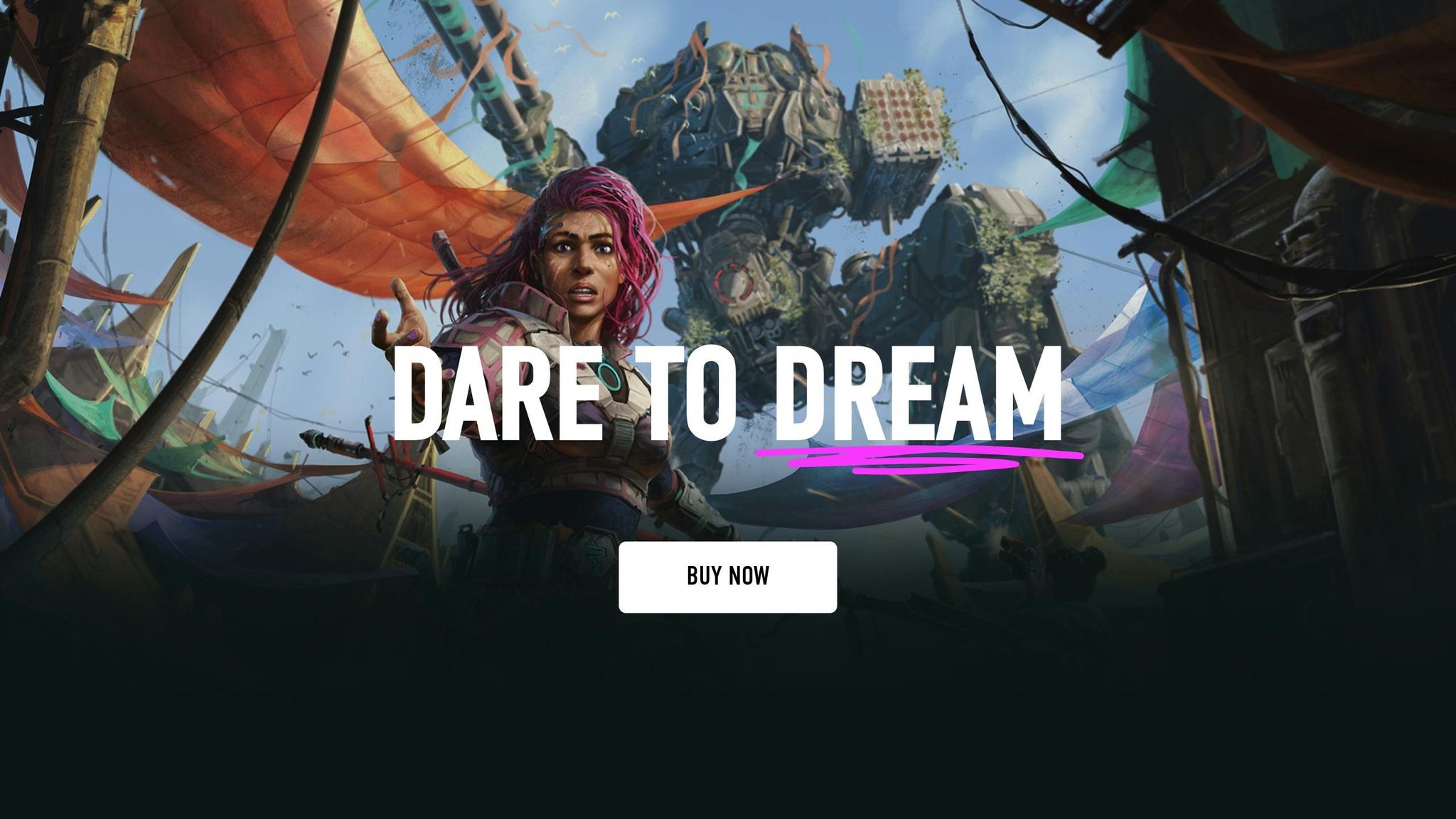
Dreams and Machines transports players to Evera Prime, a colony world trying to recover from the scars of a devastating war with AI. This Hope-Punk RPG shifts the focus from destruction to rebuilding, offering a fresh take on the post-apocalyptic genre. Drawing clear inspiration from Horizon Zero Dawn, it masterfully blends science fiction and fantasy, creating a unique setting where storytelling takes center stage.
The game uses a streamlined 2d20 system, where characters are defined by four core attributes and seven skills rated between 1–5. This simplified structure lets players dive into the narrative without being bogged down by overly complex mechanics, making it easier to focus on the story and character development.
One standout feature is the innovative Spirit system, which combines stress and fortune into a single resource. This mechanic forces players to make meaningful choices, balancing their character’s emotional resilience with their ability to shape the unfolding story. While the combat system has been critiqued for occasionally feeling repetitive, the game's overarching design remains engaging and thoughtful.
"I wanted to create something uplifting amidst a landscape of darker games", said Chris Birch, Modiphius founder and CEO.
The production quality of Dreams and Machines is impressive. The guidebooks feature a distinctive, sketchy style with annotations from an in-world character, adding a personal and immersive touch. Even the character creation process is designed to be simple and enjoyable, using cards to streamline the experience.
Teamwork is at the heart of this game, emphasizing collaboration as players work together to rebuild society. It accommodates larger groups seamlessly - working well with up to six players - and includes a tutorial and a mini-campaign to help new players hit the ground running.
For those seeking something beyond traditional fantasy, Dreams and Machines offers an exciting mix of futuristic survival and heartfelt heroism. Its themes of rebuilding and hope provide a refreshing perspective, making it a great fit for fans of Cities Without Number or anyone drawn to cyberpunk-inspired crafting and exploration. With its focus on cooperation and storytelling, this game is a standout choice for groups looking to explore a world where rebuilding is just as thrilling as survival.
4. Pirate Borg
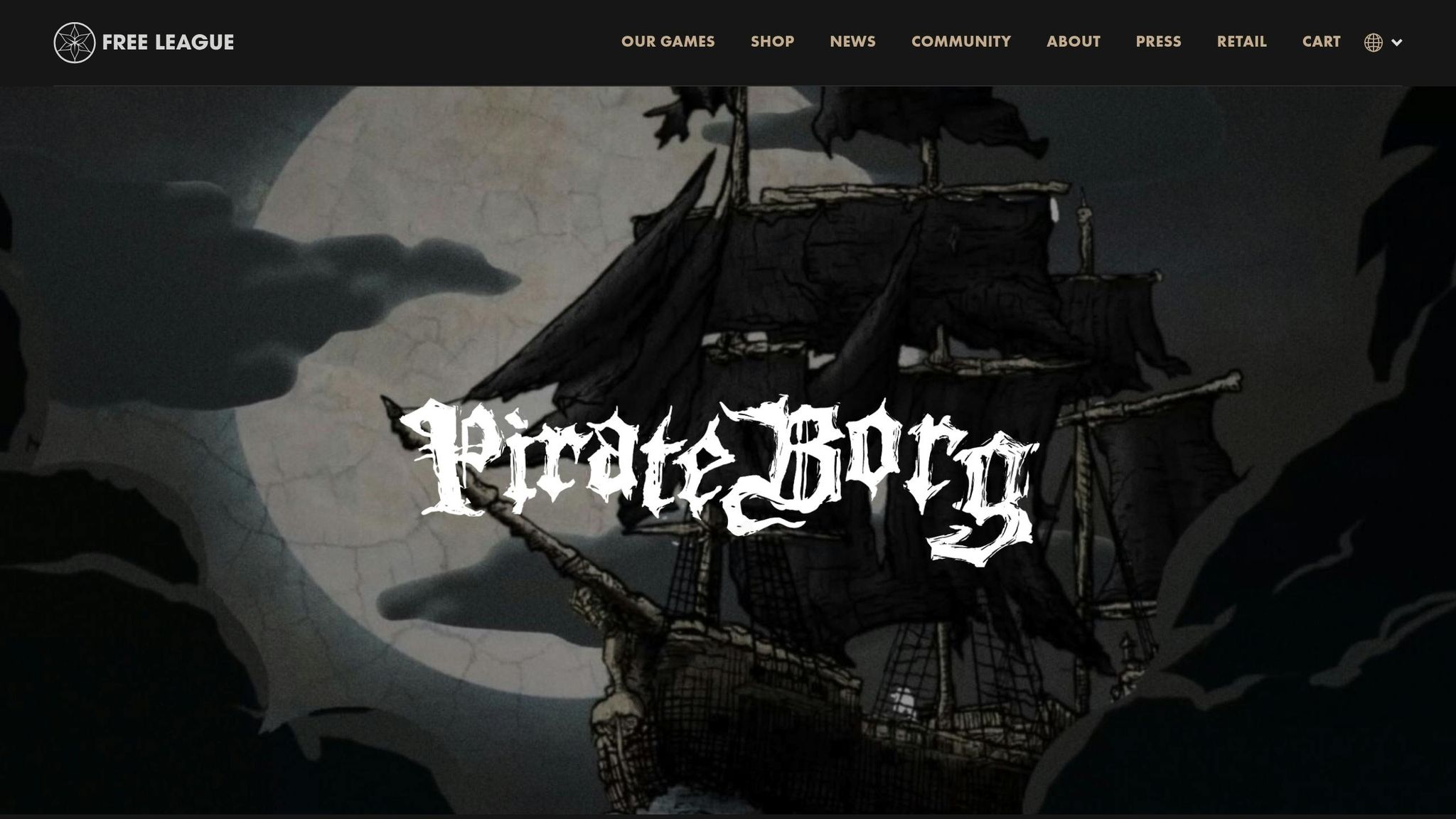
If you've ever dreamed of navigating cursed seas where undead sailors roam and eldritch horrors lurk beneath the waves, Pirate Borg brings that dark fantasy to life. This standalone tabletop RPG takes the swashbuckling pirate adventure and drenches it in supernatural dread, setting the stage in the "Dark Caribbean." Here, the Golden Age of Piracy is twisted into a world where ghostly legends and eerie lore collide with thrilling gameplay.
Built on the Mörk Borg ruleset - but requiring no prior knowledge of it - Pirate Borg offers a fast-paced, rules-light experience. Its 160+ page core rulebook is packed with content, making it easy to dive into the action. The game’s indie roots shine through with its inventive approach to gameplay and storytelling.
Creating your character is quick and fun, taking just 10–15 minutes. Random tables guide you through attributes, gear, and flaws, letting you craft a unique pirate in no time. You can choose from eight distinctive classes, including the Brute, Buccaneer, and Haunted Soul, each adding its own flavor to your band of misfits. The game fully embraces the chaotic life of a pirate, focusing on raiding, pillaging, and chasing treasure.
What makes Pirate Borg stand out is its intricate naval combat system paired with rich supernatural elements. Ships aren’t just props - they have stats and abilities, turning sea battles into intense, strategic encounters. From cannon fire to ramming and boarding, the mechanics cover every aspect of naval warfare. With stats for 18 different vessels, these battles feel as dynamic as they are essential. On the supernatural side, the game introduces ASH, a hallucinogenic substance made from undead remains. ASH is a double-edged sword: it can enhance stats and grant magical powers but comes with deadly risks. The bestiary is equally impressive, featuring over 80 creatures, from ghost ships and skeleton crews to the legendary Kraken.
The game also addresses sensitive historical themes with care, offering guidelines to avoid problematic content. For added strategy, the Devil’s Luck mechanic provides tools like rerolling dice, dodging critical hits, or maximizing damage, making the streamlined rules even more engaging.
Random treasure map generators create riddles and quests to fuel your adventures, while carousing tables add unpredictable chaos to your crew’s shore leave antics. Whether you’re a newcomer to tabletop RPGs or a seasoned player looking for a fresh spin on pirate tales, Pirate Borg delivers an immersive experience where survival hinges on your cunning as much as your cutlass.
5. Dragonbane
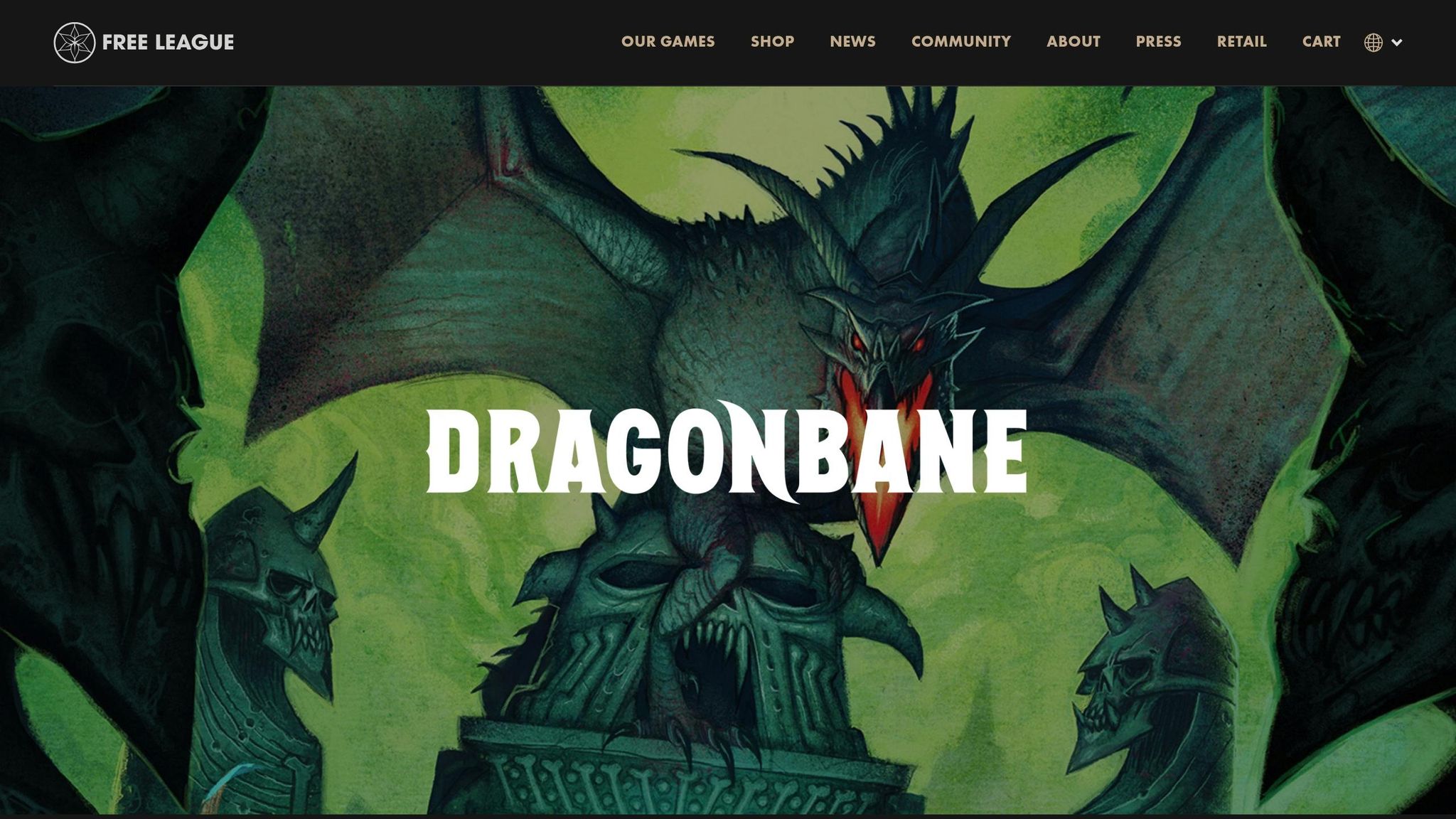
Dragonbane breathes new life into classic fantasy role-playing, blending nostalgic charm with modern simplicity. Originally launched in 1982 as Drakar och Demoner, Scandinavia's first and most iconic tabletop RPG, its recent revival has taken the gaming community by storm. The Kickstarter campaign for this updated version was fully funded in just four minutes, showcasing the excitement for its fresh approach to fantasy adventures.
At its core, Dragonbane uses a D20 roll-under system that’s fast and easy to grasp. Rolling a 1 - dubbed "rolling a dragon" - unleashes powerful special effects, while rolling a 20, or a "demon", spells trouble. This mechanic keeps gameplay exciting and unpredictable, striking a balance between simplicity and tension.
The game’s classless, skill-based system allows players to create characters around unique archetypes, avoiding rigid templates. This flexibility makes Dragonbane accessible to newcomers while offering the depth that seasoned players crave. As Wes Allen from DM Tales remarked, "Dragonbane has enough depth to make long-time gamers happy, but is so fast and clean it can keep a six-year-old's attention. It's nice."
What sets Dragonbane apart is its richly imagined setting. Drawing from the 13th-century Baltic Sea region, the game incorporates elements of Germanic and Slavic cultures, steering away from the typical English or French medieval tropes. The primary setting, the Misty Vale, is steeped in a history of clashes between dragons and demons. This backdrop provides a straightforward yet flexible foundation for storytelling, with plenty of opportunities for player-driven narratives. Combat in Dragonbane is no less engaging - its perilous nature forces players to think strategically, as monsters’ attack patterns are randomly determined, keeping battles unpredictable and fresh.
The game also shines in its attention to detail, offering rules for everyday activities that enhance immersion. Whether you're navigating the dangerous world or simply surviving its challenges, the mechanics pull you deeper into its believable universe.
One of Dragonbane's most delightful features is its selection of playable races, or "Kin." In addition to standard fantasy options, players can embody Mallards (humanoid ducks) or Wolfkin (wolf-like beings). These whimsical choices nod to the original Swedish game, adding a playful twist to its otherwise serious tone.
Critics have embraced Dragonbane with enthusiasm. Screen Rant praised it as "one of the best" tabletop RPGs of the year, while Serban Ionita from The RPG Gazette called it "a real treasure of a game", adding:
"It finds that perfect middle ground between old-school crunch and new-school narrative play."
Dragonbane rewards players and Game Masters alike with streamlined mechanics that keep the focus on storytelling and exploration. Its blend of accessible rules, immersive settings, and unique character options makes it a standout choice for anyone looking to dive into a vast, dangerous world of fantasy role-playing.
sbb-itb-b8b00a5
6. Legend in the Mist
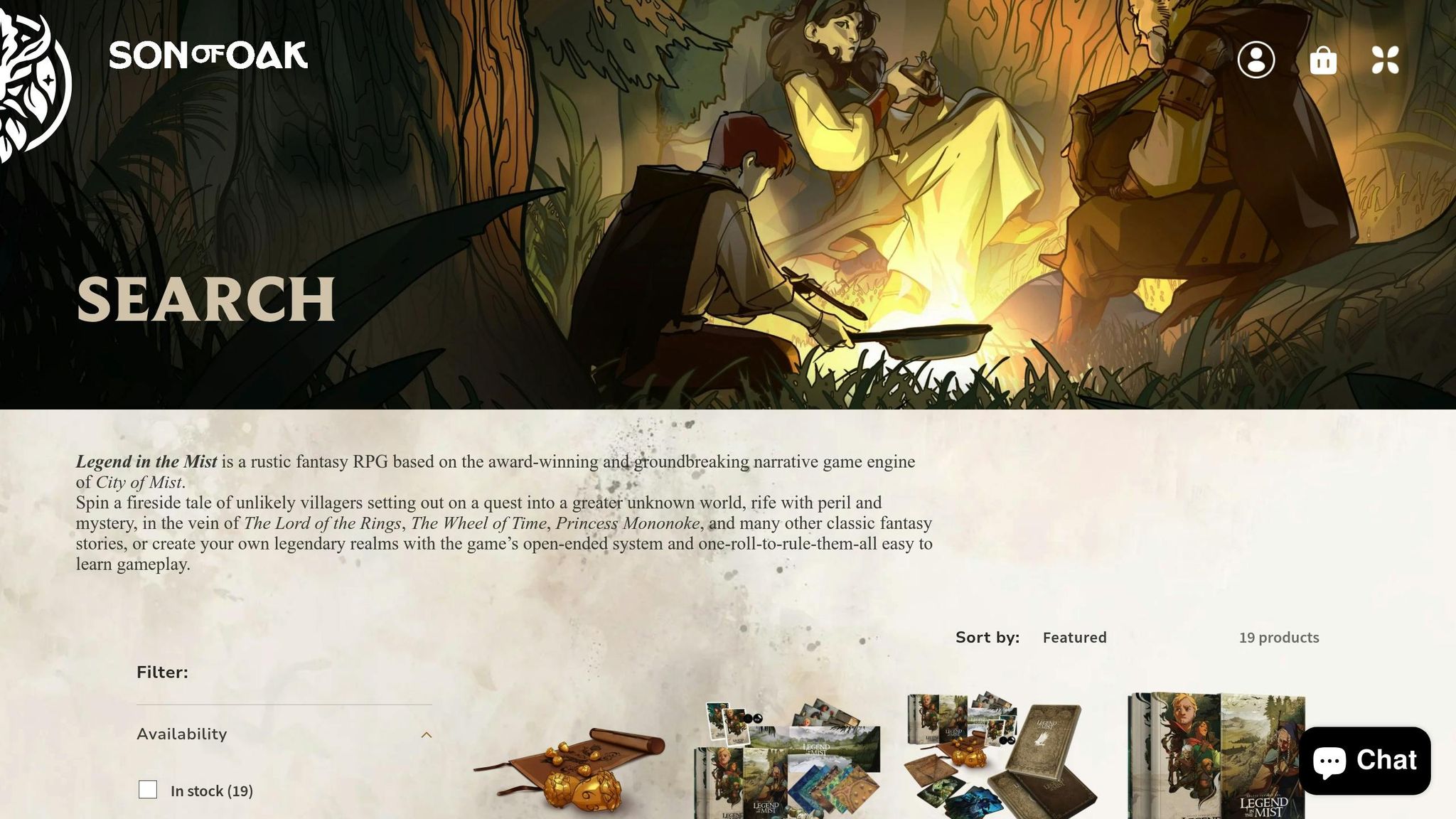
Legend in the Mist takes a bold step away from traditional tabletop RPG mechanics, trading in stat blocks and dice-heavy systems for a storytelling-focused approach. Here, your character's backstory isn't just a narrative flourish - it is your character sheet. Instead of numerical stats, the game introduces the Mist Engine, a system that uses descriptive keywords, or "tags", to define what your character can do.
Amit Moshe, the mind behind Legend in the Mist and founder of Son of Oak Game Studio, sums it up perfectly:
"It's D&D but: WAY easier to learn, and you're not locked to the same outcome with every ability."
This design philosophy makes the game approachable for newcomers while still offering layers of depth for seasoned players.
A Fresh Take on Character Creation
Building a character in Legend in the Mist revolves around three types of cards: Hero Cards, Tracking Cards, and Theme Cards. Of these, the Theme Cards are the backbone. With 20 different types divided into Origin Themes, Adventure Themes, and Greatness Themes, the system provides endless opportunities for customization.
Character growth is another area where the game breaks the mold. Instead of leveling up in the traditional sense, characters evolve through their narrative decisions. As Moshe explains:
"Characters don't so much level up as they evolve into different versions of themselves."
Even revealing your character's weaknesses becomes a strategic choice, weaving personal growth directly into the storytelling. This dynamic approach adds depth and nuance to the gameplay.
A World of Mystery and Magic
The default setting, Hearts of Ravensdale, mirrors the subtlety of the Mist Engine itself. Magic here is rare and enigmatic, with practitioners - known as Thaumaturges - discovering their powers through inner cultivation. This understated approach to magic enhances the sense of wonder and exploration.
The Kickstarter campaign for Legend in the Mist speaks volumes about the enthusiasm it has generated. With $855,686 raised from 8,156 backers, the community has clearly embraced this fresh take on tabletop role-playing. The game is set to release in digital format in March 2025, with physical copies following in June 2025. Pricing is set at $29 for the digital version and $49 for the hardcover edition.
A Return to Storytelling Roots
At its core, Legend in the Mist captures the spirit of "old fireside tales" - stories of unlikely heroes from quiet villages embarking on adventures into the unknown. The game emphasizes exploration and discovery, with mysterious magic and unfamiliar monsters adding to the thrill.
The system also ensures balanced storytelling power among all players, making it ideal for groups of any size, including solo or one-on-one sessions. For those tired of number-crunching mechanics, Legend in the Mist offers a refreshing, narrative-driven experience that reimagines the classic fantasy adventure.
7. :Otherscape
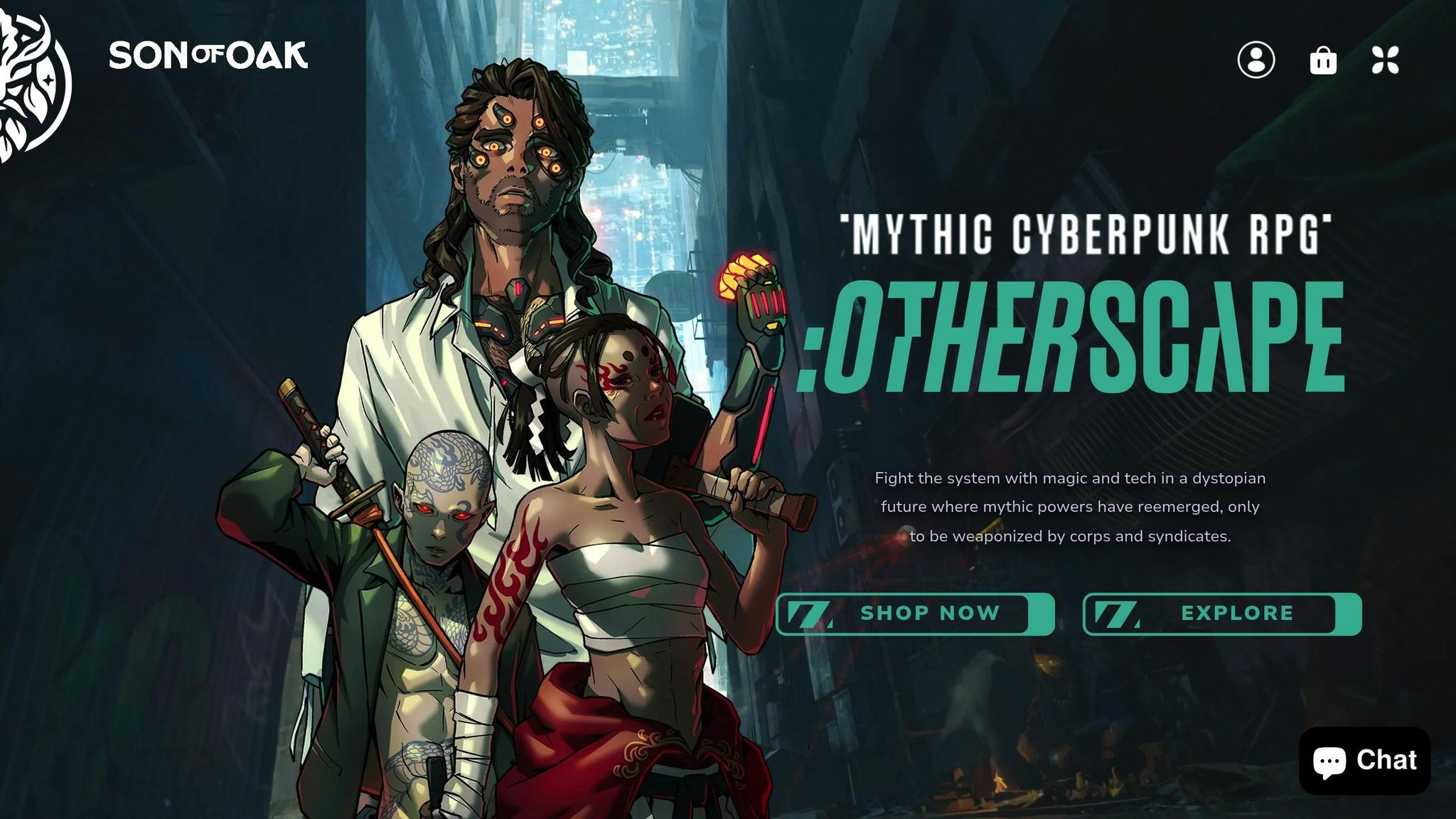
:Otherscape stands out as a hidden gem in the world of tabletop RPGs, offering a cyberpunk experience that fuses ancient mythology with cutting-edge technology. Imagine a world where hackers cast spells, corporate power struggles clash with mythical creatures, and humanity grapples with the resurgence of magic. This fantasy-cyberpunk RPG takes players on a thrilling ride, filled with intense combat, high-speed chases, and thought-provoking themes. In this universe, technology dominates daily life, but the return of magic throws everything into chaos. All of this is powered by a game engine designed to put creativity front and center.
The Mist Engine: Creativity Unleashed
:Otherscape uses a refined version of the City of Mist engine, emphasizing simplicity and imagination. Its innovative tag system allows players to resolve actions with a single roll, influenced by descriptive tags rather than intricate rules. This streamlined approach encourages freeform play, letting players dream up bold, imaginative character actions without being bogged down by complex mechanics.
Building Characters with Depth
Character creation in :Otherscape revolves around three core ideals: Self (humanity), Noise (networking), and Mythos (magical ability). Players craft their characters using Essence themekits such as Nexus, Spiritualist, Transhuman, Cyborg, Singularity, Real, and Conduit. From there, they choose four themes and three skills to define their character's abilities and personality. The game’s narrative-driven progression ensures characters evolve in meaningful ways, reflecting their struggles to balance technology and magic. As game designer Rob Wieland explains:
":Otherscape Metro puts that at the center of the game as players must fight to maintain their identities as their characters hack servers and cast spells." - Rob Wieland, Game Designer
Exploring a Futuristic Megacity
The game’s default setting is a sprawling megacity where players hunt for tangible sources of magic. The first major expansion, Tokyo:Otherscape, drops players into a futuristic Japanese city where cyberpunk technology mingles with folklore-inspired elements like yokai and yurei. To keep the action cinematic, the game offers ready-made story hooks for characters, crews, corporations, and megacities, giving Game Masters plenty of material to work with while still allowing room for customization.
Pricing Options
:Otherscape provides several ways to jump in. The Metro:Otherscape Corebook is available as a PDF for $29.95 or in a Print+PDF bundle for $39.95. The Tokyo:Otherscape supplement is priced similarly. For those who want it all, the "Cyber" Bundle, which includes all PDFs, is available for $49.95.
Rob Wieland sums up the appeal of :Otherscape perfectly:
"Bottom Line: :Otherscape Metro looms like a corporate monolith but rewards groups who take the time to get to know it with a chance to make their own future full of darkness and magic." - Rob Wieland, Game Designer
For players looking for a cyberpunk RPG that prioritizes storytelling and creativity over complex rules, :Otherscape offers a one-of-a-kind mix of mythic adventure and futuristic excitement.
8. Esoteric Ebb
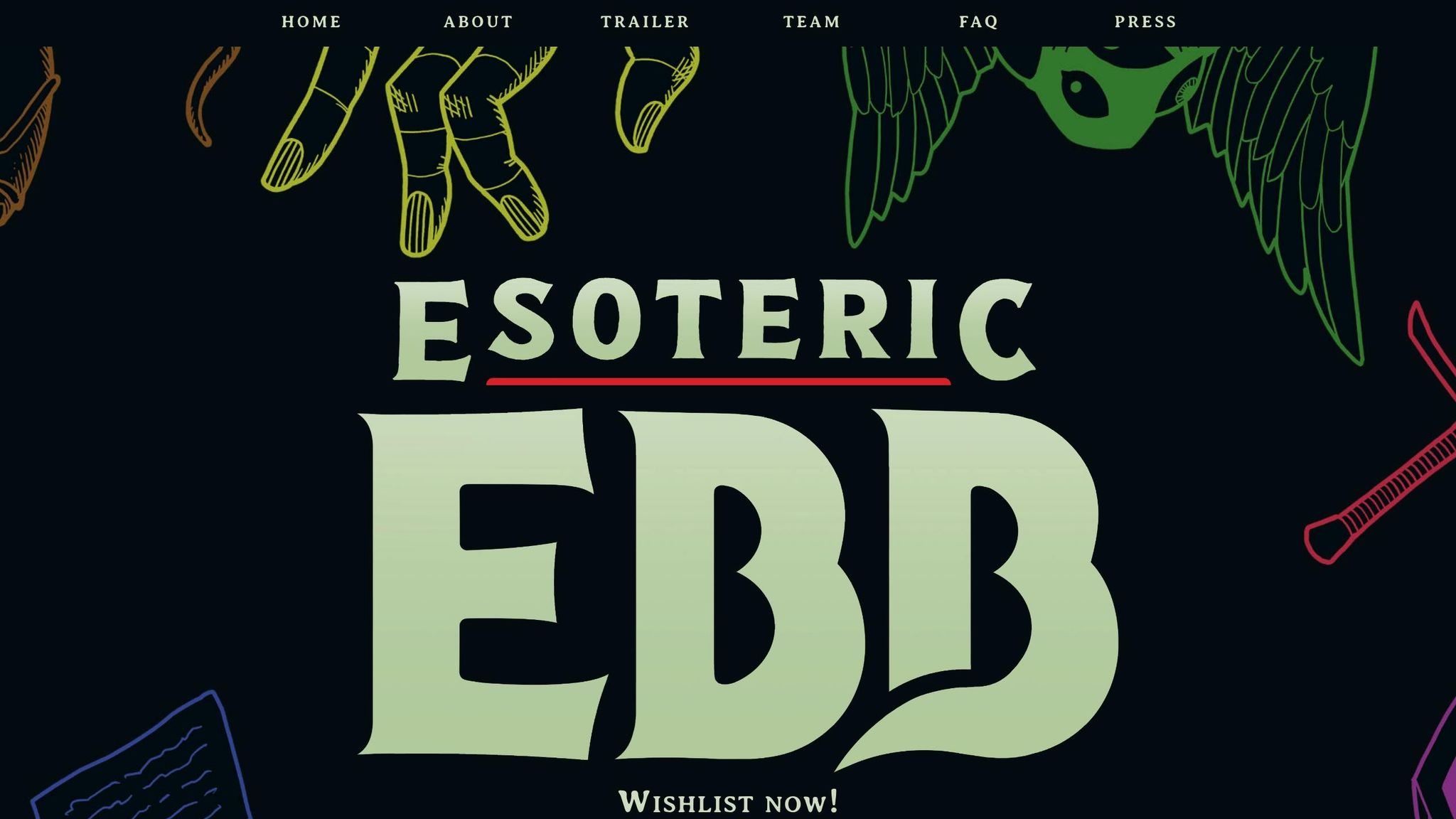
Diving deeper into the world of indie TTRPGs, Esoteric Ebb stands out by merging the narrative depth of video games with the tactile mechanics of tabletop gaming. Set in The Esoteric Coast, a post-arcanepunk world recovering from the aftermath of a magical war, players take on the role of The Cleric, a government investigator navigating the murky waters of political intrigue during Norvik's first-ever election.
Dialogue That Shapes the Story
At the core of Esoteric Ebb is its branching dialogue system, designed to make every choice feel impactful. Here’s the twist: your character’s stats aren’t just numbers - they’re personalities. These stats interrupt conversations, argue with each other, and influence how your character interprets and reacts to the world. This internal dialogue adds layers of complexity to interactions, making each decision feel like a debate within your own mind.
Game creator Christoffer Bodegård explains the philosophy behind this design:
"My definition of Agency is this: it's the feeling you get when you receive feedback on your choices. If there is no feedback, or if the feedback goes unnoticed, then there is no Agency."
To keep players engaged, the game boasts a high Choice-to-Text ratio, ensuring that every decision has visible consequences and resonates within the story. This makes the narrative not just immersive but also deeply personal.
The Questing Tree: A Visual Journey
Esoteric Ebb introduces the Questing Tree, a mechanic that blends a quest log, skill tree, and mind map into one cohesive tool. It visually tracks your progress while doubling as a character development system. This unique approach ties together investigations and personal growth, giving players a clear sense of advancement both in the story and their character's arc.
Combat Reimagined as Tactical Dialogue
Instead of traditional combat, Esoteric Ebb transforms confrontations into tactical conversations. Turn orders, hit points, and abilities are woven into dialogue, turning encounters into intricate puzzles rather than battles. This shift caters to players who enjoy strategic problem-solving and layered interactions over dice-heavy combat.
Absurd Realism: A World That Feels Alive
The game’s setting embraces "absurd realism", where fantastical elements are seamlessly integrated into everyday life. Mythical creatures run mundane errands - like selling newspapers - and ancient gods have been replaced by modern ideologies. As Bodegård puts it:
"Ebb is a quirky adventure of The Cleric and his goblin sidekick. The Esoteric Coast is supposed to be a weird setting. But to me it's all real. And that's what keeps the story grounded, despite everything fantastical and esoterical going on."
This balance between the bizarre and the believable creates a world that feels both imaginative and relatable.
Designed for All Players
Despite its intricate systems, Esoteric Ebb is designed to be accessible. According to Bodegård:
"Esoteric Ebb is designed to allow newcomers to just hop in and enjoy the interactive story, no problem."
Using a modified D&D 5e ruleset, the game feels familiar to seasoned players while remaining welcoming to those new to tabletop gaming. With plans for over half a million words in its final release, Esoteric Ebb promises a narrative depth that rivals some of the best video games, all while preserving the collaborative spirit of tabletop play.
For groups drawn to political intrigue, moral dilemmas, and character-driven storytelling, Esoteric Ebb offers a refreshing alternative to traditional dungeon crawlers. It’s a testament to how indie TTRPGs continue to push boundaries, delivering experiences that challenge and redefine the genre.
9. Aether & Iron
Aether & Iron invites players into a reimagined 1930s New York City, a metropolis suspended in the sky and powered by groundbreaking anti-gravity "aether" technology. This tactical RPG stands out with its mix of noir atmosphere, vehicular combat, and cosmic horror, delivering an experience unlike any other tabletop game.
A Skybound City Full of Choices
Picture a 1930s New York brought to life with sleek Art Deco designs and the marvels of floating city technology. The game’s setting isn’t just visually captivating - it’s alive with political intrigue and factional struggles that players can influence. With 16 different possible endings, your decisions shape the fate of this city in the clouds. It’s a dynamic playground for storytelling and strategy.
Tactical Vehicular Combat
One of the game’s standout features is its turn-based vehicular combat. Imagine high-speed chases and explosive shootouts, all unfolding on tactical grids. Players can tweak their aether-powered vehicles with upgrades like smoke screens, hidden compartments, and flamethrowers. Every encounter becomes a strategic puzzle, where your vehicle’s setup and positioning are just as critical as the roll of the dice.
Characters That Go Beyond the Fight
Aether & Iron doesn’t stop at combat. Its character system dives deeper, emphasizing personality traits like Hustle, Smarts, and Brass to shape social interactions and dialogue outcomes. This approach adds layers of complexity, reminiscent of games like Disco Elysium, but with the added twist of vehicular tactics and a noir-inspired 1930s backdrop.
A Storytelling Powerhouse
The narrative is in expert hands, crafted by writers who’ve worked on Far Cry, Mass Effect, and Sovereign Syndicate. With fully voiced characters and about 20 hours of gameplay, the story unfolds through a branching narrative that immerses players in its retro-futuristic world. Jay Zylstra, President of Seismic Squirrel, shares the team’s vision:
"We're really excited to reveal Aether & Iron to the world! We hope to bring you on an immersive journey into a retro-futuristic 1930s New York, a timeless setting of both hope and uncertainty based on many fascinating real-world people and events."
The Dark Side of Aether
While aether fuels the city’s marvels, it also harbors a sinister edge. This Aetherpunk world blends steampunk innovation with cosmic horror, as the very substance that powers the city can mutate, corrupt, and awaken unspeakable horrors. The tension between progress and peril keeps players on edge, as every technological leap comes with unforeseen dangers.
With its rich world-building, tactical gameplay, and compelling narrative, Aether & Iron offers a thrilling journey into a world where ambition and danger collide - high above the ground and deep into the unknown.
10. Tsukuyumi: The Divine Hunter
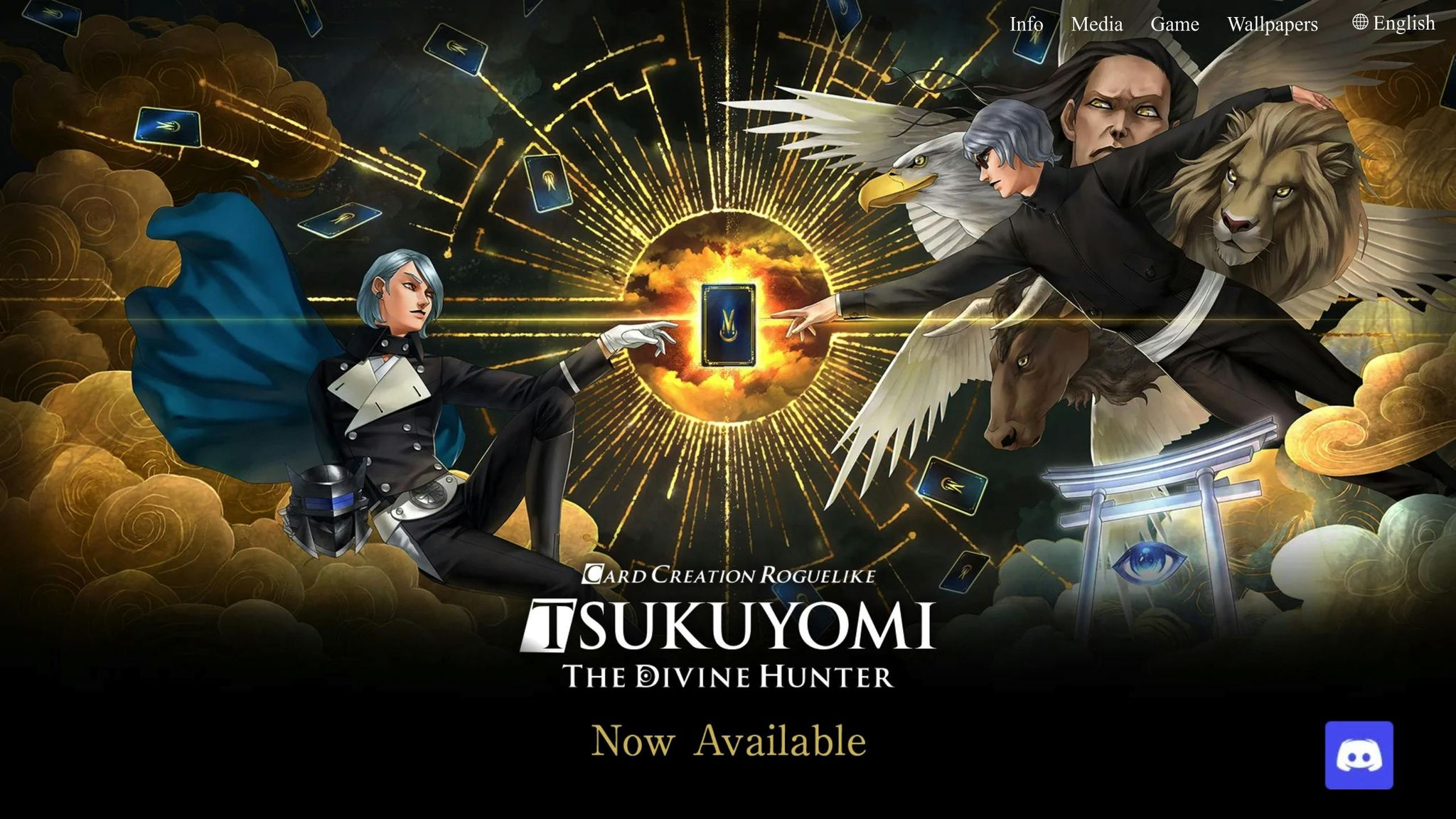
Step into a post-apocalyptic Tokyo where ancient Japanese mythology intertwines with cutting-edge technology in Tsukuyumi: The Divine Hunter. This roguelike deckbuilder carves out its own niche with AI-powered card creation, player-driven contributions, and a storyline deeply rooted in Japanese folklore.
A Clash of Gods and Machines
Set in a near-future Tokyo, the game centers around "THE HASHIRA", a towering skyscraper overrun by monstrous creatures. Here, elite Tsukuyumi hunters wage war against demons in a bid for dominance. But this isn’t your typical cyberpunk backdrop. The narrative draws from mythology, imagining a world where Tsukuyumi, the moon god exiled by his sister Amaterasu, returns after a catastrophic lunar collision that reshaped society. This fusion of mythological themes and futuristic elements creates a unique setting that drives the gameplay.
AI-Powered Creativity in Action
The game’s standout feature is the AI Kaneko system, which generates new cards and artwork based on player choices. This system is inspired by the work of Kazuma Kaneko, the celebrated artist behind Persona and Shin Megami Tensei, adding a striking visual flair to the experience. Players also have a chance to leave their mark through the "Eigetsu Offering Ritual" contest, where community-designed cards are reviewed and, if selected, officially added to the game.
Dynamic and Strategic Combat
Combat in Tsukuyumi breaks away from traditional turn-based mechanics. Instead, players make single, decisive moves that serve both offensive and defensive purposes. Each hunter comes with a unique deck archetype, meaning the effectiveness of your strategy hinges on your choice of character.
Roguelike Mechanics with Real Stakes
True to its roguelike nature, the game ensures that every loss has consequences. Losing cards and items isn’t just a setback - it also unlocks new perks for future runs. This balance between risk and reward encourages players to adapt and learn from each challenge as they ascend the perilous floors of the tower.
Divided Opinions Among Players
Despite its innovative features, Tsukuyumi has sparked mixed reactions. On Steam, it holds a "Mixed" rating, with 56% of 211 user reviews being positive. However, recent reviews show a more favorable trend, with 76% rating the game as "Mostly Positive". Over on the App Store, it boasts a strong 4.7 out of 5 rating based on 60 reviews. Yet, some critics have voiced concerns about the quality of AI-generated content and the game’s monetization model, which some feel is overly aggressive for a free-to-play title.
Kyle Clark from Noisy Pixel shared his thoughts, saying:
"The combat is enjoyable, the soundtrack is fitting, and boss fights are intense. However, the Okami system risks giving the game a bad reputation, and its AI elements left me uncomfortable."
For those eager to explore a game that blends ancient mythology with a modern twist, Tsukuyumi: The Divine Hunter delivers a distinctive and challenging experience that’s sure to leave an impression.
Game Comparison: Features and Accessibility
Here's a quick look at the core features and accessibility of some popular indie TTRPGs to help you find the perfect fit for your group.
| Game | Core Mechanics | Theme & Setting | Learning Curve | Availability & Cost |
|---|---|---|---|---|
| Blades in the Dark | Flexible system with flashback mechanics replacing traditional planning | Criminal underworld with supernatural elements | Moderate – narrative-first approach | PDF widely available, ~$20–40 |
| Shadowdark | Simplified 5e mechanics with added personality | Classic dungeon crawling with modern design | Easy – streamlined rules | PDF and print available, ~$25–50 |
| Dreams and Machines | Modiphius 2D20 system for fast-paced action | Post-apocalyptic sci-fi | Moderate – established system | - |
| Dragonbane | Roll-under, skill-based system with no levels | Classic fantasy | Moderate – skill-based progression | PDF and print available, ~$30–60 |
| Legend in the Mist | Narrative-driven mechanics focusing on character development | Blend of everyday life and mythology | Easy – collaborative storytelling | Digital bundle $29, physical $50–80 |
Accessibility Factors Worth Considering
The table gives a snapshot of each game's core attributes, but there's more to consider when diving into the indie TTRPG world. A noticeable trend among these games is the effort to simplify mechanics and reduce playtimes. For instance, Shadowdark reimagines 5e mechanics into a leaner, more personalized experience. Similarly, Dragonbane uses a roll-under system where rolling a 1 is a critical success, while a 20 spells trouble.
The 2D20 system in Dreams and Machines is designed to keep the action brisk, making it ideal for groups that prefer fast-paced gameplay without getting bogged down by complex rules. This approach reflects a broader shift in indie TTRPGs toward "fiction-first" gameplay, where the story drives the mechanics rather than rigid, dice-heavy combat.
Cost and Distribution Patterns
When it comes to pricing, digital editions typically range from $15–40, while physical copies cost between $30–80. Many publishers, like those behind Legend in the Mist, offer tiered options, including digital bundles, premium print editions, and even "pay what you want" downloads or quickstart guides. These options make it easier for players to explore a game before fully committing.
This tiered pricing model highlights how indie publishers balance accessibility with premium offerings, ensuring there's something for everyone - from casual players to collectors.
Matching Games to Player Preferences
Every group has its own style, and indie TTRPGs cater to a wide range of preferences. If you're into collaborative storytelling, Legend in the Mist might be your go-to. For players who enjoy anti-hero narratives and clever planning, Blades in the Dark is a strong contender.
For those who prefer familiar mechanics with a fresh spin, Shadowdark and Dragonbane are excellent choices. These games refine well-known systems into smoother, more accessible formats. What makes indie TTRPGs stand out is their willingness to experiment - whether it's Blades in the Dark's flashback mechanics or Dragonbane's skill-focused progression, these games push boundaries to create immersive, story-driven experiences.
Indie TTRPGs thrive on innovation, offering something unique for every type of gaming group. Whether you're drawn to fast-paced action, deep storytelling, or streamlined mechanics, there's a game out there waiting to bring your next adventure to life.
Conclusion
The indie TTRPG scene brings fresh energy and groundbreaking ideas to tabletop gaming. Games like Blades in the Dark, with its clever flashback mechanics, or Pirate Borg and its streamlined D20 system, show that some of the most inventive and captivating gameplay thrives outside the mainstream spotlight. These mechanics, discussed earlier, embody the indie spirit - pushing boundaries and reimagining how we play.
Indie games stand out because they’re unafraid to break away from conventional systems, experimenting with storytelling and player interaction in ways that feel genuinely new. Whether you're drawn to the collaborative heist planning of Blades in the Dark or the simplicity and charm of other indie systems, these games deliver experiences you won’t find in traditional RPGs.
One of the joys of exploring indie TTRPGs is their accessibility and variety. Newcomers appreciate their straightforward rules, which make diving into the hobby less intimidating, while seasoned players find fresh challenges that reignite their enthusiasm. Many of these games are available as affordable PDFs, making it easy to try something new without a big financial commitment.
Supporting indie creators does more than expand your gaming library - it helps sustain a vibrant and creative community. These designers bring fresh perspectives and bold ideas that redefine what tabletop role-playing can be. When you buy an indie TTRPG, you’re not just purchasing a game; you’re contributing to a movement that values creativity and connection over convention. Indie games also foster closer ties between players and creators, offering a sense of community that’s often missing in mainstream gaming.
Forget the outdated notion that indie games lack polish or depth. Today’s indie TTRPGs boast high-quality production and gameplay that easily rival - or even surpass - what larger publishers offer. As highlighted in the examples above, these systems breathe new life into role-playing, offering something for every type of gamer. The best way to grasp their impact? Dive in and try one for yourself.
Even a single session with an indie TTRPG can reignite your passion for tabletop gaming. With so many unique mechanics, themes, and playstyles to explore, there’s an indie game out there waiting to become your next favorite.
FAQs
How are indie tabletop RPGs different from mainstream ones?
Indie tabletop RPGs carve out their own space by focusing on new ideas, imaginative storytelling, and distinctive themes. While mainstream games often stick to tried-and-true formulas to attract a wide audience, indie TTRPGs thrive on experimenting with bold mechanics and unconventional narratives, delivering experiences that feel refreshingly different.
Typically crafted by small teams or even solo designers, these games are backed by enthusiastic grassroots communities. This setup gives creators the freedom to break away from traditional game design, making indie TTRPGs an exciting choice for players looking to explore beyond the usual big-name offerings.
How do I choose the right indie TTRPG for my gaming group?
To pick the perfect indie TTRPG for your group, start by thinking about what your players enjoy the most. Are they drawn to deep storytelling, tactical combat, or rich, character-focused plots? Choosing a game that matches these interests can help keep everyone engaged and excited.
It’s also a great idea to try out different systems to see what clicks. One-shots or short campaigns are excellent for testing out mechanics, themes, and play styles. The goal is to find a game that sparks creativity and fun for everyone - because the best TTRPG is the one your group loves diving into together.
Are there budget-friendly ways to try indie TTRPGs before buying?
If you're looking to dive into indie tabletop RPGs without breaking the bank, you're in luck. Many creators make their games accessible through pay-what-you-want pricing or even offer them completely free on community-driven platforms. Some also share free demos or downloadable content, letting you try out their inventive mechanics and storytelling styles without any upfront cost. It's a great way to uncover lesser-known treasures while showing support for indie creators on your own terms!

